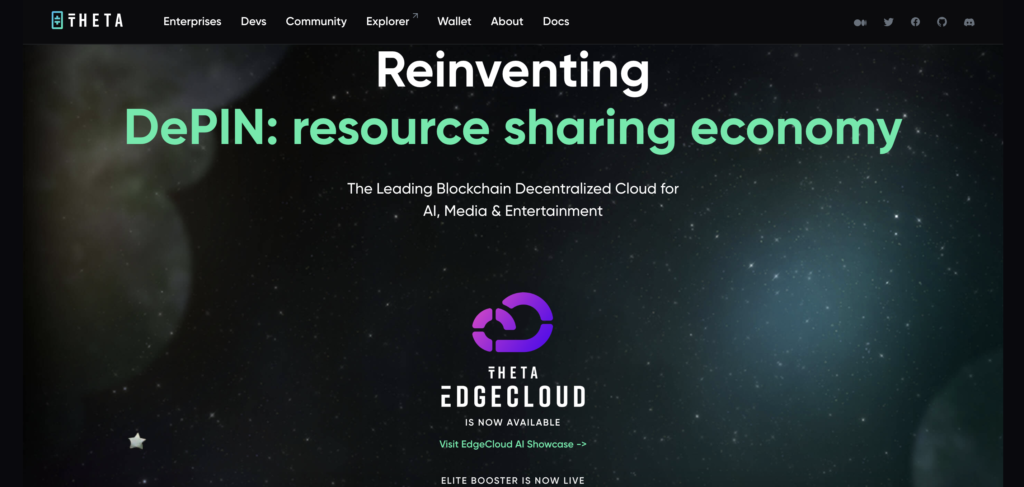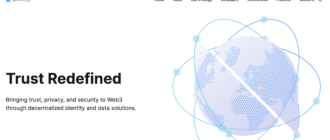Theta Network is an innovative blockchain-based platform designed to revolutionize the video streaming and edge computing landscape. This article will provide a comprehensive overview of Theta Network and its native cryptocurrency, THETA. We will delve into the project’s core components, exploring its technological infrastructure, tokenomics, ecosystem, growth prospects, and future development trajectory. By understanding these elements, readers will gain insights into how Theta Network aims to reshape the media and entertainment industry through decentralized technology.

What is Theta Network?
Theta Network is a blockchain-based platform specifically designed for decentralized video streaming and edge computing. It addresses the inefficiencies and high costs associated with traditional content delivery networks (CDNs) by leveraging a peer-to-peer (P2P) infrastructure. This setup allows users to share their excess bandwidth and computing resources, thus enhancing streaming quality and reducing costs. The platform is built on an Ethereum-compatible blockchain that supports Turing-complete smart contracts, enabling the creation of decentralized applications (dApps) for various use cases including NFTs, decentralized finance (DeFi), and decentralized autonomous organizations (DAOs). Theta’s innovative approach aims to decentralize the distribution of video content and other data-intensive applications, providing a scalable, efficient, and cost-effective solution for media and entertainment industries.
History of Theta Network
Theta Network was launched by Theta Labs, with its mainnet going live in March 2019. The project’s development can be traced through several significant milestones:
- 2018: Initial development phase and strategic partnerships with leading companies in the tech and entertainment sectors.
- March 2019: Launch of Theta Mainnet 1.0, introducing the initial network structure.
- 2020: Introduction of Guardian Nodes, enhancing the security and decentralization of the network.
- 2021: Launch of Theta Mainnet 3.0, which included the introduction of Elite Edge Nodes and the concept of Uptime Mining, allowing users to earn TFUEL by providing computing resources.
- 2022: Announcement and implementation of the Theta Metachain, enabling permissionless horizontal scaling and supporting an interconnected network of subchains.
- 2023: Expansion of the Theta ecosystem through hackathons and community development initiatives, promoting innovation in video streaming and blockchain technology.
- 2024: Launch of Theta EdgeCloud, combining the benefits of edge and cloud computing to support advanced applications in AI, media, and entertainment.
Theta Network’s evolution reflects its commitment to decentralizing media and entertainment through continuous technological advancements and strategic collaborations with global leaders like Google, Samsung, and Sony.
How Does Theta Network Work?
Theta Network operates on a sophisticated and highly efficient blockchain infrastructure designed to optimize video streaming and data delivery. The core technologies that underpin Theta include its unique consensus mechanism, decentralized network architecture, and specialized blockchain features.
Blockchain and Consensus Mechanism
Theta Network utilizes a modified Proof-of-Stake (PoS) consensus mechanism known as Multi-Level Byzantine Fault Tolerance (BFT). This consensus algorithm combines several innovative elements to achieve high transaction throughput and robust security. The system is designed to handle thousands of nodes participating in the consensus process while maintaining efficiency and low latency.
Multi-Level BFT
The Multi-Level BFT consensus mechanism is a key differentiator for Theta. It employs a hierarchical structure where a smaller subset of nodes, called the Validator Committee, initially approves transactions. These validators are typically composed of 10-20 nodes that quickly reach consensus on proposed blocks. Once these blocks are preliminarily approved, they are passed on to the Guardian Pool, a much larger group of nodes that perform final validation and commit transactions to the blockchain. This multi-tiered approach ensures rapid transaction processing and enhances the network’s decentralization and security.
Theta Edge Network
The Theta Edge Network is a decentralized network of Edge Nodes operated by community members. These nodes perform essential functions such as video transcoding, data relay, and computational tasks. By leveraging the computing power and bandwidth of Edge Nodes, Theta minimizes reliance on centralized servers, reducing costs and increasing efficiency. Participants who run Edge Nodes are rewarded with Theta Fuel (TFUEL) tokens, creating an incentive-driven ecosystem that supports the platform’s operations.
Off-Chain Micropayments Pool
To facilitate efficient micropayments, Theta employs an off-chain micropayments pool. This system allows for the aggregation and rapid distribution of micropayments using an aggregated signature gossip protocol. This method significantly reduces messaging complexity and ensures that payment transactions are processed swiftly and efficiently. The off-chain micropayments pool is crucial for enabling pay-per-byte models in streaming services, thereby optimizing resource usage and enhancing user experiences.
Technical Features
Theta’s blockchain is Ethereum-compatible, supporting Turing-complete smart contracts. This compatibility allows developers to create a wide range of decentralized applications (dApps) on the Theta platform, including non-fungible tokens (NFTs), decentralized exchanges (DEXs), and decentralized autonomous organizations (DAOs). The blockchain’s architecture also includes support for off-chain storage solutions and real-time data processing, making it a versatile and powerful platform for media and entertainment applications.
Key Distinctions
Theta Network stands out from other blockchain projects through its focused application on media and entertainment. Unlike general-purpose blockchains, Theta is specifically optimized for video streaming and data delivery, addressing the high costs and inefficiencies associated with traditional content delivery networks (CDNs). Its dual-token model, comprising THETA for governance and TFUEL for operational transactions, further enhances its capability to manage a decentralized video streaming ecosystem effectively.
Overall, Theta Network’s advanced technological infrastructure, innovative consensus mechanism, and strategic focus on the media and entertainment sector position it as a leading platform in the decentralized internet space.
Tokenomics of Theta Network
Theta Network utilizes two primary tokens within its ecosystem: THETA and TFUEL. These tokens serve distinct purposes, playing critical roles in the network’s operations and governance.
Is it a Token or a Coin?
THETA and TFUEL are both tokens, given that they are built on the Theta blockchain, which operates independently as a specialized blockchain for media and entertainment applications. This categorization differentiates them from coins, which typically operate on their native blockchains.
THETA Token
Supply and Distribution:
- Maximum Supply: The total supply of THETA is capped at 1 billion tokens, with no new tokens to be created, ensuring a deflationary model.
- Initial Distribution: THETA was initially distributed as an ERC-20 token on Ethereum before transitioning to the Theta mainnet. The initial distribution included:
- 30% for Initial Token Sale: To raise funds during the ICO.
- 7.49% for Team Allocation: Reserved for the development team.
- 1.23% for Advisors: Allocated to project advisors.
- 12.5% for Partners: Distributed to strategic partners.
- 12.5% for Network Seeding: To stimulate early network growth.
- 36.28% in Reserves: Held for future development and network support.
TFUEL Token
Role and Emission:
- Utility: TFUEL, or Theta Fuel, functions similarly to “gas” on the Ethereum network, being used to pay for transactions, smart contract operations, and rewarding participants who share their computing resources on the network.
- Inflation Rate: TFUEL is inflationary, with an annual increase rate of 5%, to incentivize ongoing participation and support network operations.
Governance and Staking
Governance:
- THETA Staking: Users stake THETA to become Validator or Guardian Nodes, securing the network and participating in governance. Validators are responsible for block production, while Guardians ensure the integrity of the blockchain by validating transactions approved by Validators.
- Governance Structure: The governance of Theta is semi-centralized, with major enterprises like Google, Sony, and Samsung serving as Enterprise Validators, which adds a layer of trust and stability.
Market Performance
Price Dynamics:
- Historical Performance: THETA has seen significant price fluctuations, with an all-time high around $15.72 and current prices substantially lower, reflecting typical volatility in the cryptocurrency market.
- Market Capitalization: THETA’s market cap indicates its substantial impact and adoption within the blockchain space, underpinned by its robust partnerships and innovative approach to decentralized streaming.
Unique Economic Model
Theta Network’s dual-token system distinguishes it from many other blockchain projects by providing a clear division of roles between governance and operational functionalities. This design not only helps in maintaining the integrity and efficiency of the network but also ensures that participants are adequately rewarded for their contributions, fostering a sustainable and engaged community.
Where to Buy THETA Cryptocurrency
THETA, the native token of the Theta Network, can be purchased on several major cryptocurrency exchanges. Here are some of the most popular platforms where you can trade THETA:
- Binance: One of the largest and most well-known cryptocurrency exchanges in the world. Binance offers a wide variety of trading pairs for THETA, including THETA/USDT, THETA/BTC, and THETA/ETH.
- HTX (formerly Huobi): Another leading global exchange, HTX provides multiple trading pairs for THETA. It is known for its robust security measures and user-friendly interface.
- Gate.io: This exchange is known for its comprehensive list of trading pairs and low trading fees. Gate.io supports THETA trading with pairs like THETA/USDT and THETA/BTC.
- Bybit: Bybit is renowned for its derivative trading options. Although it is primarily known for its futures contracts, Bybit also offers spot trading for THETA.
- KuCoin: KuCoin is popular for its wide range of altcoins and competitive trading fees. It offers several THETA trading pairs, making it accessible for a variety of traders.
How to Buy THETA on Exchanges:
- Register: Create an account on the chosen exchange.
- Verify: Complete the KYC (Know Your Customer) process if required.
- Deposit: Fund your account with fiat currency or another cryptocurrency.
- Trade: Navigate to the THETA trading pair and place your order.
Where to Store THETA Cryptocurrency
Storing THETA securely is crucial to protect your investment. Here are some of the recommended wallets where you can store THETA tokens:
- Theta Wallet: The official Theta Wallet is available on both Android and iOS. It allows you to store, send, and receive THETA and TFUEL tokens. The wallet also supports staking, enabling you to earn rewards by participating in network validation.
- Ledger Nano S/X: Hardware wallets like the Ledger Nano S and X provide a high level of security for storing cryptocurrencies. These devices keep your private keys offline, reducing the risk of hacks.
- Trezor Model T: Another popular hardware wallet, Trezor Model T, supports THETA storage and offers advanced security features to keep your assets safe.
- Trust Wallet: A mobile wallet that supports a wide range of cryptocurrencies, including THETA. Trust Wallet provides a user-friendly interface and strong security features.
- MetaMask: While primarily known for Ethereum-based tokens, MetaMask can also store THETA due to its compatibility with the Theta blockchain’s EVM capabilities.
How to Store THETA:
- Download/Install: Choose and install the wallet of your choice.
- Create an Account: Set up a new wallet and securely back up your seed phrase.
- Receive THETA: Use the wallet address to receive THETA tokens from the exchange or another wallet.
Storing your THETA in a secure wallet is essential to ensure the safety of your assets. For long-term storage, hardware wallets are highly recommended due to their enhanced security features. For everyday use and staking, the official Theta Wallet and other reputable mobile wallets offer convenience and ease of access.
Prospects of Theta Network
Theta Network’s growth is driven by its innovative approach to decentralized video streaming and edge computing, which addresses the inefficiencies of traditional content delivery networks. By leveraging a decentralized peer-to-peer infrastructure, Theta significantly reduces costs and enhances streaming quality, making it an attractive solution for media companies and content creators.
Key Drivers of Growth
- Innovative Technology: Theta’s unique Multi-Level Byzantine Fault Tolerance (BFT) consensus mechanism ensures high transaction throughput and robust security, making it a reliable platform for decentralized applications (dApps) and media delivery.
- Strategic Partnerships: Theta has established partnerships with major industry players such as Google, Samsung, Sony, and Binance. These partnerships enhance the platform’s credibility and adoption, enabling it to reach a broader audience and integrate advanced technologies.
- Adoption and Ecosystem Expansion: Theta’s ecosystem includes a wide range of projects and dApps that leverage its decentralized infrastructure. The Theta Edge Network, comprising thousands of Edge Nodes, supports real-time data processing and video streaming, attracting developers and users alike.
Clients and Partners
Theta Network collaborates with numerous high-profile companies and organizations. Key partners include:
- Google: Provides support and infrastructure for Theta’s network.
- Samsung: Integrates Theta’s technology into its smart TVs and Galaxy smartphones.
- Sony: Collaborates on various media and entertainment projects.
- Binance: Supports Theta’s blockchain through enterprise validator nodes and trading pairs.
Future Outlook
Theta Network’s roadmap for 2024 and beyond focuses on expanding its technological capabilities and ecosystem. Key initiatives include:
- Theta EdgeCloud: A hybrid cloud computing platform that supports advanced applications in AI, media, and entertainment.
- Theta Metachain: Introduced to facilitate permissionless horizontal scaling, enabling the creation of subchains for specific use cases.
With ongoing development and strategic collaborations, Theta Network is well-positioned to become a leading platform in the decentralized media and entertainment space. The platform’s commitment to innovation and ecosystem growth suggests a promising future.
Theta Network Ecosystem
The Theta Network ecosystem is robust and continually expanding, encompassing various applications and services that leverage its decentralized infrastructure.
Key Components
- Theta Edge Network: A decentralized network of Edge Nodes that perform tasks such as video transcoding, data relay, and computation. This network forms the backbone of Theta’s decentralized video streaming and data delivery services.
- Theta Video API: Provides developers with tools to integrate decentralized video streaming into their applications, enhancing user experiences without relying on centralized servers.
- Thetadrop: An NFT marketplace built on the Theta blockchain, allowing users to mint, buy, and sell NFTs, integrating digital collectibles into the Theta ecosystem.
- Theta Wallet: Supports the secure storage and management of THETA and TFUEL tokens, including functionalities for staking and governance participation.
Ecosystem Participants
- Developers: Utilize Theta’s tools and APIs to build decentralized applications, enhancing the platform’s utility and adoption.
- Content Creators: Benefit from Theta’s decentralized streaming capabilities to deliver high-quality content to their audiences.
- Enterprises: Integrate Theta’s infrastructure to reduce costs and improve the efficiency of their media delivery networks.
Overall, Theta Network’s ecosystem is designed to support a wide range of applications and services, fostering innovation and growth in the decentralized media and entertainment industry.
Conclusion
In summary, Theta Network stands at the forefront of blockchain innovation, leveraging decentralized infrastructure to enhance video streaming and edge computing capabilities. Through its advanced technological framework and strategic partnerships, Theta is poised to address critical challenges in the media and entertainment sector. As the platform continues to evolve, it promises to offer scalable solutions that cater to the growing demand for decentralized services. By fostering a robust ecosystem and maintaining a clear focus on future developments, Theta Network is well-positioned to achieve significant milestones and drive forward the next generation of Web3 applications.






